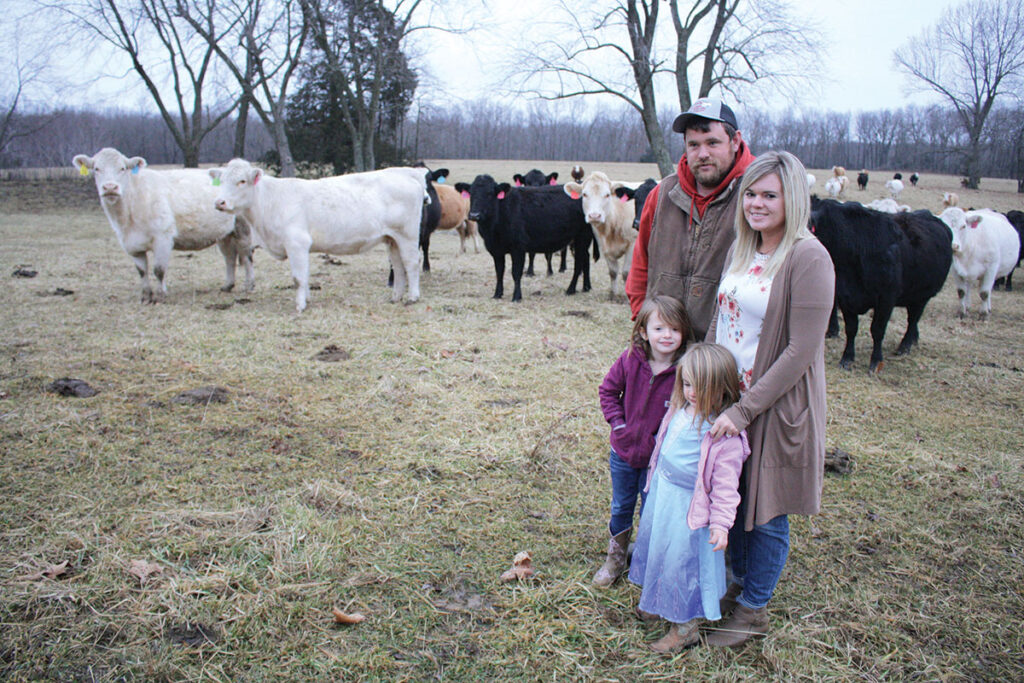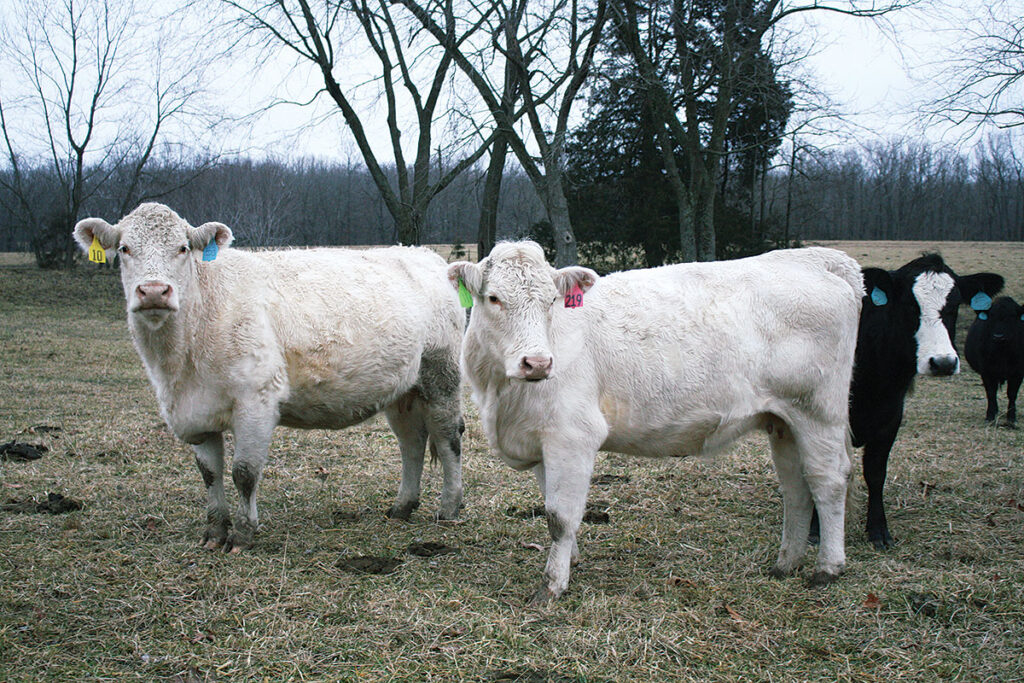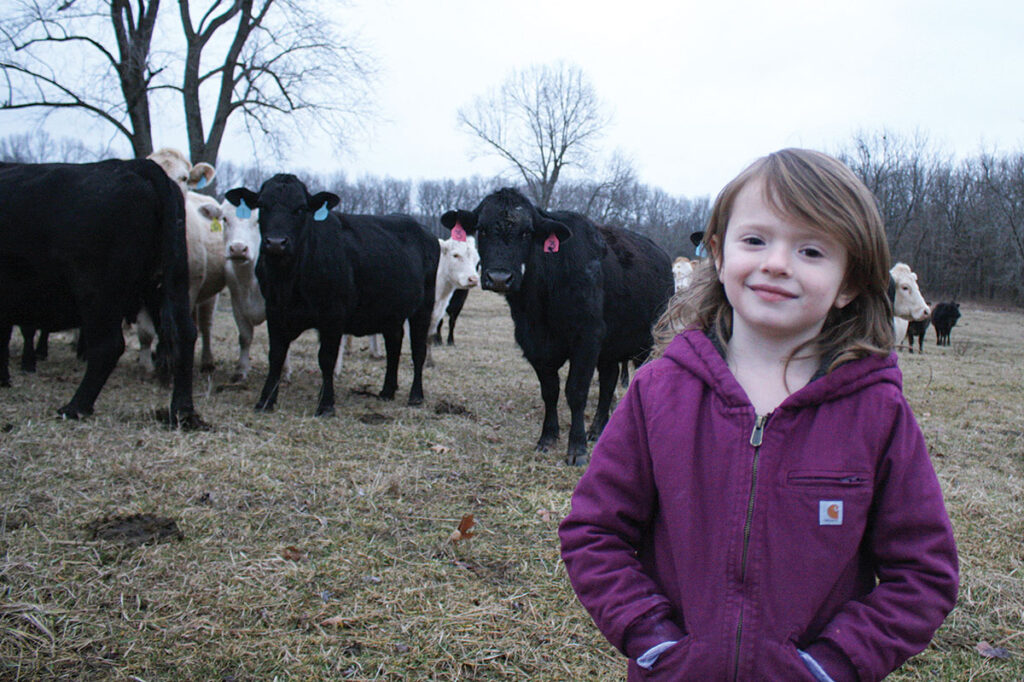
Dustin and Krystal Cook market their farm-fed beef to hungry consumers
Dustin Cook and his family are deeply rooted in the Ozarks. He’s the fifth generation of his family, on both his maternal and paternal sides, to farm family land near Conway and Lebanon, Mo. He and his wife Krystal are now raising the sixth-generation, their daughters Riley and Kinsley, on the family farm.
Dustin wanted to milk, but the dairy industry’s uncertainty prompted him to lean toward a cow/calf operation.
“We got married in 2011 and bought this place after my great grandpa, Herbert Vincent, passed away, and we bought our own herd of cattle,” Dustin recalled. “Two years ago, my grandpa (Derrell Cook) and his brother (Lonnie Cook) on the other side of the family decided they were getting out, so we bought their cows and rent that farm.”
Dustin and Krystal operate a herd of about 70 cows, along with additional cattle owned by Dustin’s father and Krystal’s brother.
“We started with bottle calves,” Krystal said. “We had 50-some calves in the barn, and that was two hours of bottles in the morning and two hours at night. Then we bought a black herd, which is what I wanted. When we bought his grandpa’s herd, it is Charolais and Charolais-cross.”
Dustin said the Charolais and Charolais-influenced calves finish better and fill out quicker than his black-hided cattle, a trait he appreciates.
“The market likes black cattle, but my grandpa (Derrell Cook) had Charolais, and my great-grandpa (Bill Cook) had one of the first Charolais bulls in the country,” Dustin said. “He gave outrageous money for that bull at the time. That first year we bought their cows and calved them out, the Charolais put 150 pounds on our calves.”
Charolais are now the predominant herd sires in the Cook herd, and they have added a red-factor Charolais bull to the breeding program.
“You get more of the cream-colored calves, and when you cross them with the black cows, you get a really good calf,” he said.
The Cooks retain many of their heifers for their breeding herd and appreciate the hybrid vigor their crossing program has produced in those females.
“We have some excellent females,” Dustin said. “Sometimes when you buy heifers, you’re getting someone else’s’ problem, so we just keep our own; then you know what you have.
“We have heifers that we have their momma and grandma,” Krystal added. “There are certain cows that when they calve, and it’s a heifer, you know that heifer is staying here.”
Dustin and Krystal both also have off-the-farm jobs. Krystal also raises Border Collies and Dustin custom hays, but they began investigating other revenue streams for their farm, which is about 1,000 acres of owned and rented land.
Since they are cattle producers, the pasture-to-plate beef business made sense, and Cook Family Farms Custom Beef began last year.
“We had talked about it for a couple of years,” Dustin said, adding that they began working on licensing last winter.
“COVID slowed everything down, but we butchered our first steer for sale in June,” Krystal said. “If we had been psychic and known about COVID, I would have gotten it done sooner. We were right behind the curve.”
Luckily, the Cooks had appointments at Tom’s Slaughter House in Montreal, Mo., which is a USDA-inspected facility.
“We were booking appointments right before COVID,” Krystal said. “We currently have some for every month through the end of the year and into 2022.”
“We butcher every two weeks,” Dustin added.
The couple offers customers ground beef, steaks, roasts and other cuts.
“Some months, it seems like nothing will sell,” Krystal said with a laugh. “Then in one week, it’s gone. A few weeks ago, we had 600 pounds of burger, and I thought we would never sell that much, but I have no burger now until we get the one back that’s hanging right now. It kind of goes in waves. Last year, we butchered about 40 in total, starting in June. We have been blessed. When we started this, I thought there was no way we were going to sell them, but there are several months where we are booked four to five months on advance on beef on hoof. And that’s with butchering five a month, plus our retail side.”
On the retail side, customers can also request customized bundle or just a cut or two.
“They tell me how much they want to spend, and I will put something together for them,” Krystal said. “If they want more hamburger, I will get them more hamburger, or they want less hamburger and another roast, I’ll put it together. I will switch things out until they are happy with their bundle. It’s a lot of work, but it’s something you have to offer because not everyone can come up the money for a whole or half, or even a quarter.”
By offering retail cuts, the Cooks are able to offer high-quality beef to customers who might not have room to store or can afford a whole, half or even a quarter of beef.
They are also finding more and more customers are new to buying beef directly from the producer.
“They love the beef,” Krystal said. “They ask if the meat will taste different than the store.”

“People will cook our hamburger and say they never knew there could be a difference in the taste of hamburger, but there is,” Dustin added. “You won’t go to the store and find a steak or burger that tastes as good as what you’ll get from us.”
In addition to retail cuts, the Cooks also sell animals on the hoof. Because they have appointments booked at Tom’s, customers can use those spots, and the Cooks will deliver to the processor.
Cattle for the beef program, including the retail cuts and on-hoof sales, are finished at the Cook Farm. Several of the animals are from the Cook herd, with others purchased from a local buyer.
“I don’t calf out year-round, so we do have to buy some, but everything is finished out right here on this farm,” he said. “We start calving around Feb. 5 or 6, and we try to have a 60-day calving window, but it usually turns into a 90-day season. We can’t justify trying to calve year round to do the beef. With calving once a year, you have some that’s too big or too small to work for the custom beef, hence we have to buy a few. I just can’t bring myself to keep a bull in year-round. I know when all of my calves will be coming, and I would rather keep it that way.”
Calves born on the Cook farm are offered grain and hay at weaning, which is at about 600 pounds. They go into the feeding pasture at about 800 to 900 pounds.
Raised and purchased calves receive a commercial ration that includes corn, soybean and alfalfa pellets, and about 16 percent protein for 120 days before being processed.
“They get about 25 to 30 pounds (of feed) a day,” Dustin said. “We try to get them close to 1,200 pounds. They get grass, hay and feed.”
They have a mineral and supplement program in place, vaccinate and worm calves twice a year, and work closely with their veterinarian. Purchased calves are also vaccinated and wormed.
While they are new to the pasture-to-plate industry, the Cooks are finding a tremendous customer base.
“People have driven three to four hours to buy meat,” Krystal said. “We’ve had several from Kansas City. We have people who have ordered more than one quarter or half, or they have bought on the retail side and then placed an order for a quarter or a half. It feels really good to know they are happy with their beef.”
Customers sometimes ask if the beef they order is a certain breed, if it’s organic or non-GMO. Dustin and Krystal are honest with their customers, only claiming that their animals are true-farm raised, grain-finished beef, the same meat they serve to their own family.
“We don’t use hormones or steroids, but we can’t claim them to be 100 percent organic or non-GMO since our grain isn’t. I try to explain to people that they will not know the difference in what breed it is since we have a black and white herd,” Krystal said.

The Cooks’ goal for 2021 is to have 60 animals processed for both markets, and are toying with the idea of a brick and mortar location.
“We want to specialize in beef and not have too many irons in the fire,” she added.
Dustin said adding the retail and on-hoof sales is additional work, and there are some additional expenses involved, but it also gives his family a new cash stream.
“In farming, you have to diversify,” Dustin said. “When prices are low, you have to figure out another day to sell them, other than just going to the sale barn. We have other options.”







